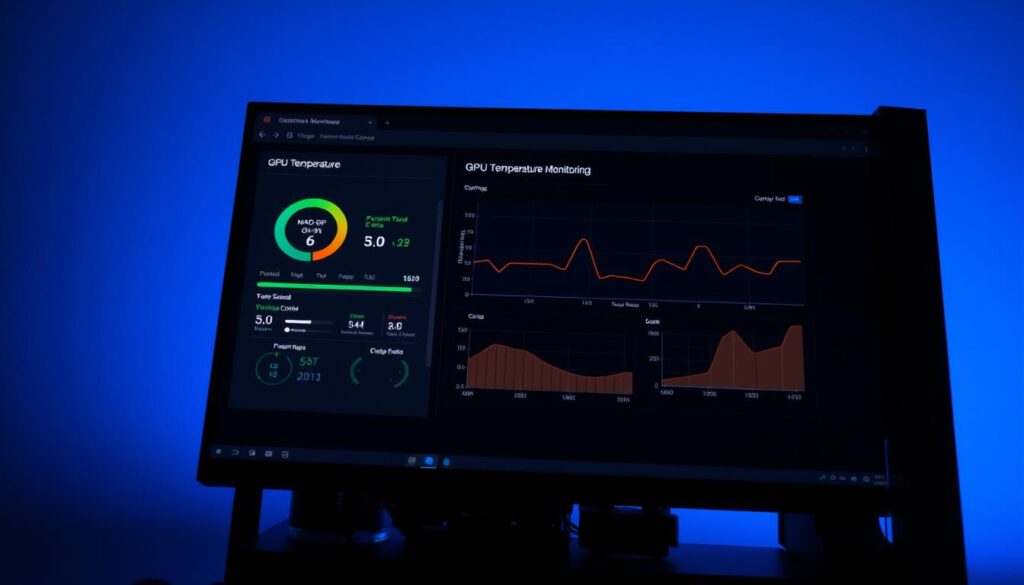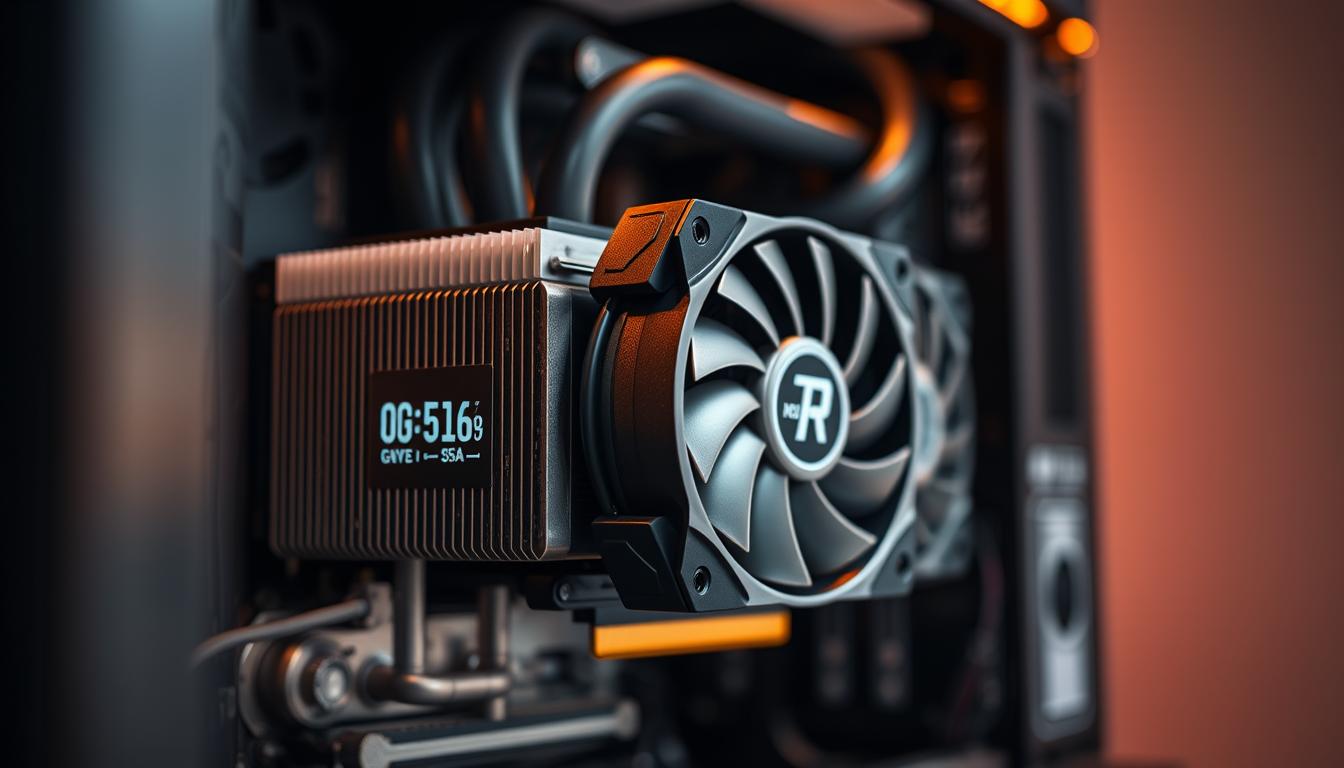Last Updated on August 18, 2025 by Gill
Remember that sinking feeling when your screen freezes mid-game? I do. Last summer, during a heated Fortnite match, my PC suddenly shut down – a victim of its own fiery graphics card. That moment taught me what every PC enthusiast learns eventually: temperature control isn’t optional.
Modern graphics cards work like athletes – they need optimal conditions to perform. While gaming or rendering, Nvidia cards typically stay safe between 70-85°C, while AMD models prefer temperatures closer to 70°C. Push beyond 95°C, though, and you’re playing with fire. Literally.
Thermal throttling doesn’t just ruin your killstreak. It slowly strangles your hardware’s lifespan. Windows 10’s Task Manager (CTRL+SHIFT+ESC) gives real-time temperature readings – your first defense against meltdowns.
This guide isn’t about fear. It’s about empowerment. Whether you’re battling in Cyberpunk 2077 or mining cryptocurrency, you’ll discover practical ways to protect your investment. Cleaner airflow? Smarter settings? We’ve tested eight strategies that actually work.
Your graphics card deserves better than a slow roast. Let’s give it the cool, efficient environment it needs to shine – today, tomorrow, and through countless gaming marathons to come.
Understanding GPU Temperature Challenges
Picture your graphics card as a marathon runner stuck in a sauna—it can’t perform its best when overwhelmed by heat. Three main villains team up against your hardware: demanding software, cramped environments, and sneaky dust buildup.
Common Causes of Overheating
Modern games and creative software act like personal trainers for your GPU—pushing it to its limits. Titles like Cyberpunk 2077 or rendering projects in Blender make components work overtime. But even powerhouse cards sweat when airflow gets blocked.
Dust turns cooling systems into fuzzy blankets. Just 1/8 inch of buildup on fans can reduce airflow by 25%. Combine this with poorly arranged case cables, and you’ve created a heat trap. Many users forget that room temperature matters too—a 75°F room adds 10-15°F to internal temps.
Effects on Performance and Longevity
When things get too hot, your graphics card plays defense. Thermal throttling cuts clock speeds, turning buttery-smooth gameplay into a slideshow. Over months, constant heat exposure weakens solder joints and degrades thermal paste—like sun damage to car paint.
Studies show GPUs running above 85°C for extended periods may lose 30% of their lifespan. The fix? Spot early warning signs like fan whine or sudden frame drops. Your hardware’s health depends on breaking the heat cycle before it becomes a crisis.
Monitoring Your GPU Temperature & When to Take Action
Ever noticed your game stuttering during an intense boss fight? That’s your graphics card waving a red flag. Regular temperature checks let you catch issues before they escalate – think of it as a routine health check for your hardware.

Using Windows Task Manager and Software Tools
Hit CTRL+SHIFT+ESC to launch Windows Task Manager. The Performance tab shows real-time stats in degrees Celsius – your GPU’s vital signs. Idle temps usually sit around 40-50°C, while modern games can push this to 80°C or higher.
For deeper insights, try free tools like MSI Afterburner. These track temperature trends over time, showing how your card handles different tasks. Historical data helps spot patterns – maybe your setup runs hotter during 4K streaming than VR sessions.
Identifying Danger Zones and Thermal Throttling
Consistent readings above 90°C demand attention. At 95°C, thermal throttling kicks in – your GPU slams the brakes to prevent damage. You’ll notice sudden frame drops in Call of Duty or choppy playback in Premiere Pro.
Check your card’s specs: most manufacturers list safe ranges between 80-90°C. If temps hover near the upper limit during normal use, it’s time for cooling upgrades. Minor spikes during loading screens? Probably normal – focus on sustained highs instead.
Mastering Heat Management for Peak Performance
Imagine your gaming rig as a high-performance engine – without proper cooling, it’s just burning money. We’ve curated eight battle-tested strategies that tackle heat from multiple angles. Let’s start with the basics before diving into technical tweaks.
Smart Solutions for Every Skill Level
Begin with quick wins: cleaning dust buildup improves airflow instantly. Software adjustments like fan curve optimization take minutes but slash temps by 5-10°C. More adventurous? Undervolting reduces power draw without sacrificing frames.
Here’s the golden rule: always test changes incrementally. A 10% fan speed boost might solve your issues without extra noise. For hardware modifications, thermal paste replacement offers the biggest rewards – often dropping temps 15°C on older cards.
Your Action Plan Starts Here
1. Download monitoring tools like HWInfo
2. Baseline your current temperatures
3. Implement one solution at a time
4. Measure results after each change
Casual gamers often find success with case fan adjustments and driver updates. Enthusiasts running 4K resolutions might combine undervolting with improved airflow. Remember – sustainable cooling comes from multiple small improvements working together.
Enhancing Cooling with Improved Airflow and Fan Adjustments
Your gaming setup breathes like a living organism – every component needs fresh air to thrive. Let’s transform your case into a wind tunnel that keeps components chill without sounding like a jet engine.

Setting a Custom Fan Curve
Tools like MSI Afterburner put you in the pilot’s seat for cooling control. Create gradual speed increases starting at 50°C – this prevents sudden noise spikes while stopping heat buildup. Most cards handle 70% fan speed comfortably during gaming.
Test different curves: aggressive profiles work for competitive play, while gentler slopes suit casual use. Pair this with your GPU’s native software for unified control. Remember – consistency beats maximum RPMs every time.
Maximizing Case Airflow
Front-mounted intake fans should outnumber rear exhaust units. This positive pressure setup pushes cool air directly toward your graphics card. For tower cases, add bottom-to-top airflow using vertical mounts.
Open-air coolers love this approach – they soak up fresh breezes like solar panels catching sunlight. Blower-style designs? They need clear exhaust paths. Use zip ties to tame cable jungles blocking airflow routes.
Pro tip: Place a tissue near case vents. If it sticks, you’ve got strong intake. If it blows away, exhaust dominates. Balance these forces for optimal thermal performance across all components.
Maintaining Your GPU: Cleaning, Dust Removal, and Case Management
Ever opened your PC case to find a furry dust colony thriving inside? That fluffy enemy silently strangles your system’s cooling power. Regular maintenance keeps components breathing easy – let’s explore two game-changing tactics.
Using Compressed Air Safely
Power down completely before starting. Unplug cables and press the power button to discharge residual electricity. Ground yourself by touching metal – static shocks can fry delicate circuits.
Hold fans still with a toothpick while blasting compressed air. Spinning them at high speeds wears out bearings fast. Work outdoors to avoid redistributing dust through your room.
Angle the nozzle 45 degrees when cleaning heatsink fins. Short bursts work better than continuous sprays. For stubborn buildup, use soft brushes designed for electronics.
Effective Cable Management
Messy wires create roadblocks for airflow. Start by unplugging unnecessary case connections. Use velcro straps or braided sleeves to group power cables neatly.
Route major bundles behind the motherboard tray when possible. Leave at least 1 inch clearance around your graphics card’s fans. This simple process can drop temps 3-5°C instantly.
Schedule deep cleans every 3-6 months depending on your environment. Pair this with quarterly cable management checks. Your rig will thank you with cooler operation and easier upgrade paths.
Optimizing Hardware Performance: Undervolting and Thermal Paste Replacement
Two often-overlooked tweaks can significantly drop your graphics card temps. While fans and airflow grab attention, smarter voltage control and thermal paste maintenance deliver lasting results. Let’s explore these advanced techniques that balance performance with cooler operation.
Undervolting for Lower Heat Generation
Undervolting works like tuning a car engine – you maintain speed while using less fuel. By reducing voltage through software like MSI Afterburner, your GPU generates less heat without sacrificing frame rates. Most cards handle 50-100mV reductions safely.
| Method | Tools Needed | Difficulty | Temp Reduction | Frequency |
|---|---|---|---|---|
| Undervolting | MSI Afterburner | Intermediate | 5-12°C | One-time setup |
| Thermal Paste Replacement | Isopropyl alcohol, paste | Advanced | 10-20°C | Every 2-3 years |
Replacing Degraded Thermal Paste
When your graphics card runs hot despite clean fans, old thermal paste is likely the culprit. This conductive material between the chip and cooler dries out over time. Replacement requires careful disassembly – but the payoff matches the effort.
Use 90% isopropyl alcohol to clean the chip surface. Apply a pea-sized dot of fresh paste, then reassemble using even pressure. Properly executed, this refresh can restore cooling efficiency to near-factory levels.
Conclusion
Your graphics card’s cooling system is its lifeline during intense gaming sessions. Combining multiple strategies – from basic dusting to advanced undervolting – creates layered protection against heat buildup. Regular temperature checks using tools like HWInfo help spot issues before they escalate.
Start with simple wins. A clean system with organized cables often drops degrees Celsius faster than complex tweaks. Adjusting fan curves through software takes minutes but delivers immediate results. For those ready to level up, replacing thermal paste breathes new life into older hardware.
Consistent performance thrives below 85°C. This sweet spot preserves your graphics card’s longevity while handling modern games. Pair good airflow with quarterly maintenance – your rig will reward you with stable frame rates and fewer crashes.
Every step matters. Whether you’re battling in Elden Ring or streaming 4K content, proactive care prevents costly repairs. Your gaming experience depends on those crucial degrees – manage them wisely, and your hardware will deliver peak power for years.
FAQ
What’s the safest way to clean dust from my graphics card?
Can adjusting fan curves damage my GPU?
How often should I replace thermal paste on my GPU?
Does case airflow really impact GPU temperatures?
What’s considered a dangerous GPU temperature during gaming?
Is undervolting better than lowering power limits for cooling?
Can vertical GPU mounting affect temperatures?
Do aftermarket coolers help with high GPU temps?
- Optimize Your GeForce RTX 5070 Performance with Our Bottleneck Tool - October 2, 2025
- GeForce RTX 5090 Bottleneck Calculator: Optimize Your Setup - October 1, 2025
- GeForce RTX 5080 Bottleneck Calculator: Optimize Your Setup - September 30, 2025











